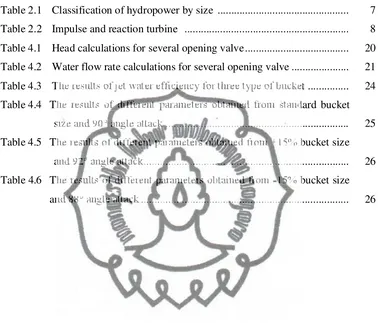INFLUENCE OF VOLUME AND ANGLE ATTACK OF PELTON TURBINE BUCKET ON THE EFFICIENCY OF MICRO HYDRO
THESIS
Organized to Meet a Part of the Requirements to Achieve the Master Degree of Mechanical Engineering Department
By:
Mohammed Meqdad Saleh Alnakhlani
S951208515
POSTGRADUATE PROGRAM
SEBELAS MARET UNIVERSITY
SURAKARTA
2014
perpustakaan.uns.ac.id digilib.uns.ac.id
MOHAMMED MEQDAD SALEH ALNAKHLANI, Student Number: S951208515
INFLUENCE OF VOLUME AND ANGLE ATTACK OF PELTON TURBINE BUCKET ON THE EFFICIENCY OF MICRO HYDRO Supervisor I: Dr. Dwi Aries Himawanto, S.T., M.T. Supervisor II: D Danardono Dwi Prija T, S.T., M.T., Ph.D. Thesis: Mechanical Engineering Department, Graduate School, Sebelas Maret University.
Abstract
Pelton turbine is an engine that facilitates continuous power as a wheel or a rotor continually turns due to the pressure of fast moving water through the bucket, where a bucket receives water from the surging nozzle. The objective of this research was to investigate the highest efficiency among different types of pelton turbine through the modification of bucket volume, bucket angle attack. The experiment was conducted at Energy Conversion Laboratory of Sebelas Maret University. The comparative study among the different parameters shows that the value of maximum efficiency was 19.58%, which was obtained at +15% bucket size and 92o angle of attack. It was gained likely due to the collision produced by the jet water in the middle of the bucket, in which the water loading occupied the large area on the surface of the bucket and promoted the increasing speed. It is expected that the result on the appropriate size and angle attack of bucket of this experiment can be manufactured in the future or develop it for achieving maximum pelton turbine efficiency.
Keywords:Pelton Turbine, Bucket volume, Bucket Angle Attack, Efficiency.
PREFACE
Foremost, I would like to express my gratitude to my supervisors Dr. Dwi Aries Himawanto, S.T., M.T for his continuous support during my master study and research, I am extremely grateful for his patience, motivation and enthusiasm to
convey his immense knowledge. He was very helpful for me in the all time of my
research and writing of this thesis. Besides to the head of mechanical engineering
department Dr. Techn Suyitno, ST. MT, I would also like to thank the rest of my thesis committeeD Danardono Dwi Prija T, S.T., M.T., Ph.Dfor his encouragement, teaching and insightful comments. My sincere thanks also go to my classmates in
UNS University for their stimulating discussions and helping. And last but not least, I
would also like to dedicate this work to my beloved parents and my family for their
moral and financial supports, I am totally convinced that I would never come to exist
and have succeeded without them. Thank you all. Sincerely
.
LIST OF CONTENTS
CHAPTER I INTRODUCTION ... 1
1.1 Background of the study ... 1
1.2 Problem Statement ... 2
1.3 Research Limitation ... 3
1.4 Objectives ... 3
1.5 Significance of the Study ... 3
CHAPTER II LITERATURE REVIEW ... 4
2.1 Study Literature ... 4
2.2 Basic Theory ... 5
2.3 Micro Hydro ... 9
2.4 Bucket ... 9
CHAPTER III RESEARCH METHODOLOGY ... 13
3.1 Materials and Equipment ... 13
3.2 Methods and Scheme of Research ... 13
3.3 Data Analysis... 14
CHAPTER IV RESULT AND ANALYSIS ... 19
4.1 Head Measurement ... 19
4.2 Water Flow Rate Measurement ... 21
4.3 Triangle Velocity ... 22
4.4 Electric Power and Efficiency Measurement ... 24
CHAPTER V CONCLUSION AND SUGGESTION... 30
5.1 Conclusion ... 30
5.2 Suggestion ... 30
REFERENCES ... 31
LIST OF FIGURE
Figure 2.1 Impulse turbine ... 7
Figure 2.2 Reaction turbine ... 8
Figure 2.3 Schematic diagram of micro hydro electric power plant ... 9
Figure 2.4 Schematized view of a pelton turbine ... 10
Figure 2.5 Pelton turbine bucket ... 10
Figure 3.1 Installation pelton turbine test ... 13
Figure 3.2 Flow Chart of Research... 14
Figure 3.3 Standard pelton turbine bucket... 15
Figure 3.4 New design of pelton turbine buckets ... 16
Figure 3.5 Pelton turbine testing scheme... 17
Figure 4.1 Relation between opening valve and the head ... 20
Figure 4.2 Triangle velocity in pelton turbine bucket ... 22
Figure 4.3 A view of the relation between the flow rate and efficiency at different bucket size and angle attack ... 27
Figure 4.4 A view of the relation between the flow rate and rpm at different bucket size and angle attack ... 28
Figure 4.5 Jet water... 29
LIST OF TABLE
Table 2.1 Classification of hydropower by size ... 7
Table 2.2 Impulse and reaction turbine ... 8
Table 4.1 Head calculations for several opening valve... 20
Table 4.2 Water flow rate calculations for several opening valve ... 21
Table 4.3 The results of jet water efficiency for three type of bucket ... 24
Table 4.4 The results of different parameters obtained from standard bucket size and 90° angle attack ... 25
Table 4.5 The results of different parameters obtained from +15% bucket size and 92° angle attack... 26
